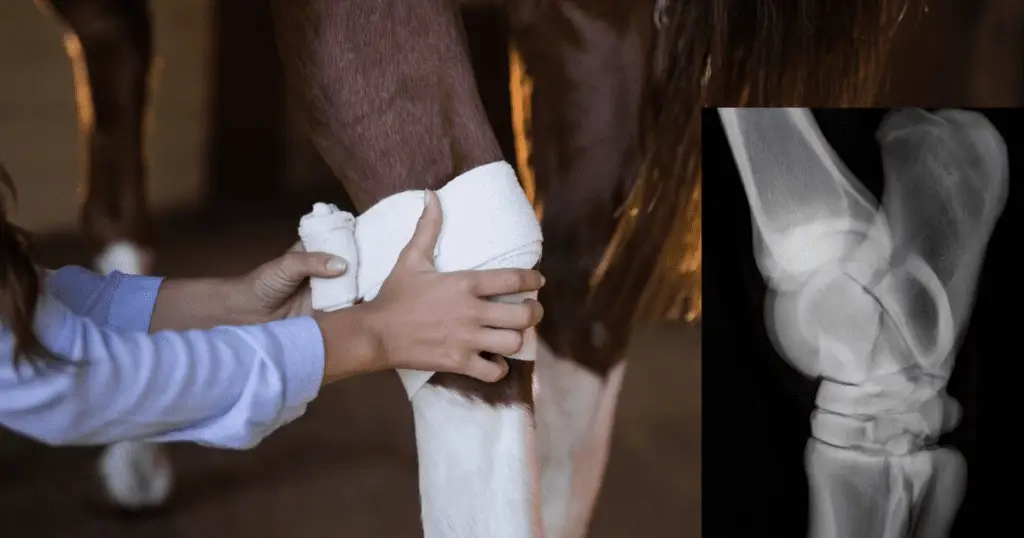Learning How To Bandage a Horses Hock is important as it is a delicate process that requires care and attention to detail. A poorly placed bandage is often worse than no bandage at all. If the bandage is loose and slips it can increase the healing time by disrupting the healing bed by rubbing and a bandage too tight can cause damage to the blood supply and cause severe damage and white hairs to appear!!!. Here is a step-by-step guide to help you properly bandage a hock on a horse:
Materials you will need:
- A clean, dry bandage roll (cotton wool/Gamgee etc)
- Non-stick gauze pads or poultice (depending on age of wound and contamination)
- Vet wrap (self-adhesive bandage)
- Scissors
- Elastoplast (optional but advised)

How To Bandage a Horses Hock- Complete 7-Step Guideline
How To Bandage a Horses Hock- Complete 7-Step Guideline
Step 1: Disinfect the Wound
Know your anatomy and seek veterinary advice if you are unsure of the depth of the wound or structures that may be involved. If the joint is damaged the sooner it is attended to by a vet the better the prognosis. But in the meantime……….Clean the wound and surrounding leg with a disinfectant first and then flush with water (sterile saline if joint is involved). Before bandaging the hock, ensure that it is clean and dry.
Step 2: Apply a Non-Stick Gauze Pad or poultice to the wound.
Take a non-stick gauze pad and place it over the wound. The gauze pad should cover the entire wound and wrap around it slightly. This will help protect the wound or injury and prevent the bandage from sticking to the skin. If the wound is contaminated with dirt/sand etc, it is best to place a poultice bandage to the wound for the first 4 days and bandage as per described.
Step 3: Start Bandaging
Take a clean, dry roll of cotton wool or gamgee (some type of padding) and start wrapping it around the hock, starting from just below the hock and working upwards. Be sure to keep the bandage snug, but not too tight, as it can restrict circulation.
Step 4: Overlap the Bandage
Overlap each layer of the bandage slightly to ensure that it stays in place. Be careful not to overlap too much, as this can create a bulky bandage that may interfere with the horse’s movement. Keep the point of the hock at the back free from wrap.
Step 5: Secure the Bandage with Vet Wrap
Once the bandage has been wrapped around the hock, use vet wrap to secure it in place. Vet wrap is a self-adhesive bandage that sticks to itself but not to the skin. Start wrapping at the top of the bandage and work your way down, making sure to cover the entire padding. Once at the joint area use a figure 8 pattern to keep the point of the hock at the back free. There is a very important tendon at the back of the hock which is like a human achilles tendon and needs to be protected when wrapping, so DON”T WRAP TOO TIGHT.
Step 6: Cut Excess Vet Wrap
When you get to the bottom of the bandage, cut the vet wrap and tuck the end of the wrap into the bandage to secure it. Apply some Elastoplast to the top of the vetwrap if you want to make sure it doesn’t slip
Step 7: Check the Bandage
After bandaging the hock, ensure that the bandage is snug but not too tight. Check the horse’s circulation by feeling the pulse in the pastern. The pulse should be strong and regular. Check the bandage regularly to make sure it is still secure and not causing any discomfort to the horse.
Video: How To Bandage a Horses Hock?
Conclusion
In conclusion, bandaging a hock on a horse requires care and attention to detail. Follow these steps to ensure that the bandage is secure, comfortable, and provides the necessary protection for the horse’s hock. If you have any doubts or concerns, it’s always best to consult a veterinarian.
Also Read:

